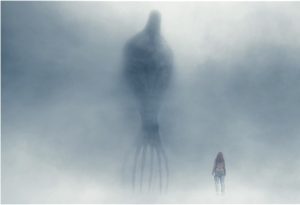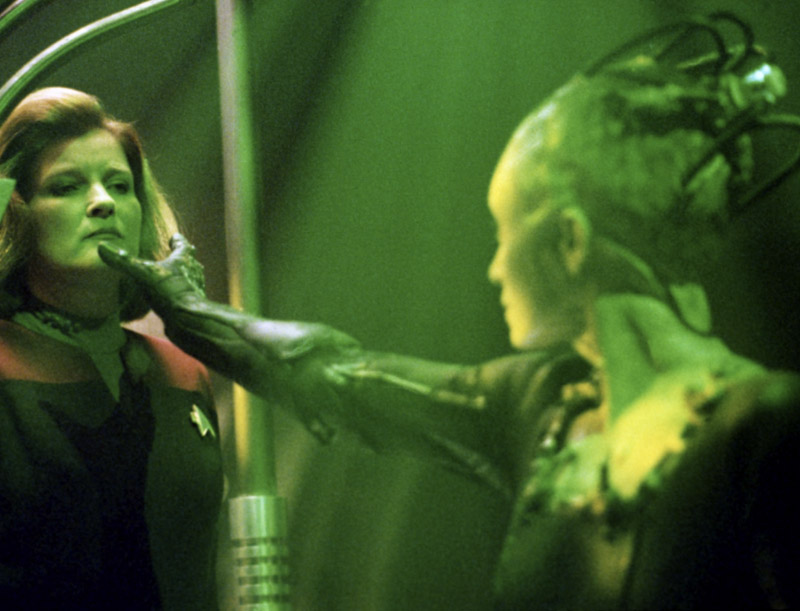Medium: “Pop culture’s creations far surpass what science says is possible.”
10-minute reading time
Jaime Green. (2018). How We Imagine Aliens: Pop culture’s creations far surpass what science says is possible. Medium.
All our imagining of what aliens look like is just that: imagining.
Our world is full of aliens. Ones that we’ve imagined, I mean. Large-headed, large-eyed, silver- or green-skinned visitors on UFOs. E.T. the Extra-Terrestrial’s wide-set eyes, wrinkled brow, and glowing finger. Prosthetic-foreheaded Klingons and prosthetic-eared Vulcans and prosthetic-eared Romulans. Martians who look like humans — lots of aliens who look like humans, actually: four-limbed and upright, except for the ones who are nonorganic beings of pure energy or light. They’re psychic or telekinetic or eyeless or faceless, sometimes, but usually not. Especially on screen, they’ll look like us — for the sake of empathy or the simple constraining factor of needing to use human actors. Hence the variety of prosthetics, especially in the decades before computer-generated aliens could join us on screen. (And even then, we missed the prosthetics, in the face of floppy, boneless Jar Jar Binks.)
Whether it’s done by scientists, writers, or visual effects specialists, all our imagining of what aliens look like is just that: imagining. And the bigger, more highly evolved the aliens are that you want to imagine, the bigger the leaps you need to take. Researchers who explore the possibility of microbial life beyond Earth, the different chemistries and microscopic structures that could give rise to life, do so with a practical eye. Their work can offer search parameters to astronomers pointing increasingly sensitive telescopes at planets beyond our solar system, with the chance to detect signs of life — not to mention for researchers designing probes to visit Mars and the possibly habitable moons of the outer solar system. Far fewer scientists spend time thinking about the possible forms of complex life, not just cells that use energy and hold information in DNA or its analogue, but the analogue of animals, the analogue of us.
The aliens of pop culture are rarely scientific projections.
Aside from the lack of applications for such thought experiments, there just aren’t enough constraints to call that speculation science. Astrophysicist Adam Frank told me, “If you want to use the constraints that science gives you to try and say something about life, then you’re limited to things that are super simple and things that are as complicated as we are.” Frank’s research includes modeling alien civilizations — he prefers the term “exocivilizations,” to match “exoplants” — as agents of climate change. Any technological civilization will necessarily have an impact on the energy balance of its home planet. So we can model that, and we can model exotic cell chemistries, but anywhere in between those two extremes is impossibly murky. At least for science.
The aliens of pop culture are rarely scientific projections. Sometimes a linguist comes in to devise a new language — still spoken, though, usually, like from a Klingon mouth with sharp prosthetic teeth or a Na’vi face CGIed — but most depictions of fictional extraterrestrials are driven by narrative and aesthetics. They’re also constrained by our understanding of life on Earth. The more-alien aliens are usually just extrapolations from nonhumanoid life on Earth: “lizard men and insectoids,” as Frank put it.
The more-alien aliens are usually just extrapolations from nonhumanoid life on Earth: “lizard men and insectoids.”
The simple path of thinking in that translation is: What if a different branch of the evolutionary tree attained sentience? Sometimes it’s bugs or reptiles, the B-movie classics. In Sue Burke’s novel Semiosis, it’s plant life on a planet a billion years older than Earth, with a billion years more evolutionary time. In Vernor Vinge’s A Fire Upon the Deep, it’s wolf-like creatures that compensate for their lack of humanoid dexterity by functioning as multiorganism beings, psychically linked individuals made up of three or four wolves. (Vinge’s world also has sentient plants and spiders.)
The supposition that life on another planet would follow similar forms as on Earth — plants and animals, humanoids and lupines — isn’t just an easy fictional gloss. It’s an extrapolation from the phenomenon of convergent evolution, when disconnected species evolve the same features independently, because those features are evolutionarily useful. Not every Earth animal with wings or a camera-like eye evolved from a common ancestor. Whales evolved fish-like features but are no more closely related to fish than cows are. So, on another planet with light or air, similar traits might evolve independently again. Same, the thinking goes, for the usefulness of chlorophyll in stationary plants, the usefulness of being a wolf or a spider, and the usefulness of hands. And of intelligence. They’ve all evolved on Earth because they’re useful, so they could very well evolve in parallel somewhere beyond.
![]() In Avatar, James Cameron depicted a sentient, humanoid alien race — just taller and thinner and blue — and went so far as to sketch out the whole world around them, an ecological and evolutionary context. Most animals we see on Avatar’s Pandora have six limbs — a perfectly fine number of limbs; Earth’s insects do just fine. But whether as a nod to anthropomorphic familiarity or for motion-capture ease, the Na’vi have only four limbs.
In Avatar, James Cameron depicted a sentient, humanoid alien race — just taller and thinner and blue — and went so far as to sketch out the whole world around them, an ecological and evolutionary context. Most animals we see on Avatar’s Pandora have six limbs — a perfectly fine number of limbs; Earth’s insects do just fine. But whether as a nod to anthropomorphic familiarity or for motion-capture ease, the Na’vi have only four limbs.
Paleontologist and science educator Katie Slivensky wrote about the movie’s “cutesy way of explaining this,” a brief glimpse of a tree-dwelling primate analogue whose middle and front limbs seem to be partly fused, an evolutionary stepping-stone between six limbs and four. But to Slivensky’s dismay, a tree-climbing monkey-type is the very last animal that would find four limbs evolutionarily advantageous over six. Making matters worse, Pandora’s ground-dwelling animals keep their extra limbs, but, Slivensky points out, “Animals that specialize in running along the ground…evolve to reduce how much their limbs come in contact with the ground. Therefore, if any animal on Pandora should fuse limbs, it would be these ground-dwelling ones. But in every instance of a ground-dwelling critter on Pandora, it of course has six limbs.” So close, James Cameron, and yet so far.
This isn’t about policing pop culture for scientific accuracy, of course. (That would be a very bad way to do science outreach.) (That last parenthetical was a direct address to Neil deGrasse Tyson.) Slivensky told me, “A lot of pop culture goes more for the imagination than the accuracy.” But, she added, if you’re going to go ahead and not just invent an alien creature but also try to depict its evolutionary context, “It’s actually really easy to just talk to someone for five minutes and get an accurate scientific take on something. It gives you that extra layer of realism.”
Convergent evolution offers a logic for aliens to be similar to us, extrapolating from the scale of one planet to the cosmos. The idea of panspermia does something similar — scientists believe all life on Earth had a common ancestor. What if life across the cosmos did, too? This is a bit of a hedge, often invoked to answer (without answering) the question of the origin from life: It came from somewhere else, where it already existed. Perhaps life only evolved once, and it’s been seeded over and over again from that single origin.
In science fiction, this often takes the shape of a progenitor race that spread its offspring across the cosmos, sometimes setting them on divergent evolutionary paths or deliberately tweaking genetics. In these stories, life itself usually evolves independently on many planets, but the ancient progenitors are the single source of sentience. This is the underpinning of Ursula K. Le Guin’s Hainish Cycle, a cluster of books and short stories set in a future in which many civilizations — descendants of the ancient civilization of Hain — are coming back together in a scientific and diplomatic consortium.

Scene from Star Trek: The Next Generation — “The Chase”
That consortium reads like a looser version of Star Trek’s Federation, and Star Trek’s humanoids also have their origin in panspermia. But curiously, it’s not a bedrock of world-building foundation there, but the reveal of a one-off episode from a late season of Star Trek: The Next Generation. In this episode, “The Chase,” the crew of the Enterprise discovers a computer algorithm encoded in the DNA of species from almost two dozen planets spread across the galaxy.
When compiled, it reveals, by way of video message, that the humanoid species of the galaxy were all seeded by one ancient race, a lonely civilization that wanted the galaxy to be bountiful with intelligent life. So they dusted their genetic code across the cosmos, a small gift for the future, an evolutionary nudge. They hoped, the progenitor in the video message says, that piecing together this history would bring their daughter races together, across their differences. Weirdly, this momentous revelation has no ripples beyond the end of the episode. (Gene Roddenberry had actually built a theory of convergent evolution into the Star Trek worldview to account for the profusion of humanoid aliens in the original series. But now, I guess, it’s doubly explained.)
Star Trek aliens tend to be either lightly prostheticked humanoids or nonbiological — made of rock or crystal or pure thought or light. When I mentioned those to astrobiologist Caleb Scharf, he said: “On the one hand, it’s nice that they’re reaching for something really alien, but in a sense, it’s a copout to say, ‘Well, it’s pure energy’—whatever that means—‘and therefore we can’t really comprehend it.’” He said the really interesting aliens are creatures of biology that we still can’t understand.

Scene from Arrival with the alien heptapod.
Perhaps no story has delved as deeply into imagining a truly alien consciousness as Arrival, both in movie form and in the Ted Chiang short story from which the film was adapted. Communication with its alien heptapods becomes a matter of understanding how their language, and thus consciousness, works. “I love the fact that the physicist is like, ‘Oh, we’re going to show them math that you know they’ll understand,’” says Frank. “That’s been the trope since Carl Sagan: ‘We’ll start with prime numbers.’ And that just doesn’t work at all.” Their way of thinking turns out to be just as alien as their physiology.
Even the heptapods can be communicated with, though, in the end. There’s little point in telling a story about fully incomprehensible aliens (except as terror, as with Alien’s xenomorphs). But our stories and our scientific hopes hinge on common ground to intelligence — math and vocalized or written language, radio waves and spaceships. Scharf, however, questions whether intelligence is even an evolutionarily favored trait. This gets back to the Drake equation and the odds of an intelligent civilization’s long-term survival. If intelligence leads to self-destruction, it won’t be favored by natural selection. We could be a blip that soon burns itself out.
All of our imaginings are inherently incredibly limited. It’s like trying to imagine a new color or a new sense. Our frame of reference is what scientists call n=1, one example to extrapolate from: one sentient species, one planet, one evolutionary tree. Seth Shostak, senior astronomer at the SETI Institute, told me, “We always extrapolate from what we are to what we figure they are. It’s a little bit self-centered.” Moreover, it misses the point. “If you think about it, the most important thing we’re doing in this century is inventing our successors.” What Shostak means by that is intelligent machines. Far less romantic to commune with than big-eyed ET.
Stories of alien visitation often call for aliens far more advanced than we are; we’re not able to go find them yet, so they have to come to us. So, Shostak said, “If you’re going to say the aliens are what we will become, then the aliens are machines.” He believes biology is just a phase in the evolution of intelligence, on Earth and beyond. “As soon as you have a computer that has a cognitive capability of a human — which, according to most people who think about that, is going to happen by 2030 — then within 30 more years, you have a machine that has the cognitive ability of all humans put together.” Machine intelligence is unconstrained by the slow, accidental procession of Darwinian evolution. Machines can design their own successors. As Shostak put it, “A baby is no smarter than the babies that were born a hundred or a thousand or ten thousand years ago. Whereas machines — .” Each generation of computers is smarter than the next.
Machines are better than biology at increasing their intelligence, and they’re better at spacefaring, too. Science fiction goes to great lengths to invent generation ships and cryostasis to ferry delicate humanoids through the stars, but even still, a plausible story often involves radiation sickness from all that interstellar travel. An intelligent machine, on the other hand, could just bolt a rocket onto its backside and go.
But maybe that view is also constrained by our n=1 problem. Slivensky thinks there probably is biology that can survive interstellar travel; it’s just nothing like ours. She brought up the example of the TRAPPIST-1 system, a family of seven Earth-sized exoplanets orbiting the same star:
If we’re so hamstrung by our own biology that even life on Earth can baffle us, how do we hope to comprehend alien intelligence?
If there was ever a time that biology evolved to be able to cross empty space and colonize another world, that would be the perfect ecosystem set-up for that. Just like on Earth we had some species cross the Atlantic on vegetation rafts from Africa to South America, maybe there’s some sort of debris flying in [the TRAPPIST-1] solar system that picked up some species and took them to another world. If those species that could survive space travel made it [to another planet], that’s a huge evolutionary boost.
With that boost, you have natural selection selecting for the ability to withstand space travel. We know that even some Earth biology can do it — there are tardigrades, at least, that can survive in outer space, plus hordes of “extremophiles,” life that thrives in conditions we thought violently inhospitable: acid mine-drainage systems, ocean-floor vents.
If we’re so hamstrung by our own biology that even life on Earth can baffle us, how do we hope to comprehend alien intelligence? In the novels that explore alien sentience — easier in prose than in onscreen images — we still often get narration from the alien point of view. They still see and think and feel, in their way.
Plenty of intelligence right here on Earth is alien enough to us as it is. Consider the octopus.
Plenty of intelligence right here on Earth is alien enough to us as it is. Consider the octopus. We understand its biology far better than its intelligence or, as its surprising intelligence suggests it may have, its view of the world. How would you begin to start a conversation with an alien intelligence even stranger to us than that?


